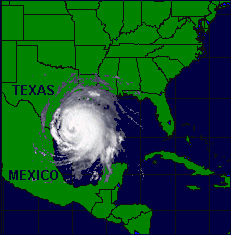Audrey2Katrina wrote:That's an interesting graphic, and it certainly lends credence to just what the surge of the infamous "Last Island" hurricane of 1856 might have been (Being in the Vermillion Bay area). This is estimated to have been a Cat 4 storm, and while no verifiable data is available on the surge that turned a barrier island resort complete with multiple-storey hotels and gambling casinos into a rent-into-pieces sandbar had to have been at least in the 15-20 ft. range IMO. This would also correlate to your graph well.
And while I agree with most of what you posted, including the Betsy comment, (I remember her well), I can't say I quite understand your comments about Carla. Perhaps that is because I'm not fully comprehending what you mean by "destructive" as there have been many storms that have far outstripped Carla in "destruction" as measured by either death toll, or damage figures. I DO remember when she hit Texas, as a child I watched with childlike thrill the televised reports; (not to mention never missing a report by our own local favorite: Nash Roberts, pulling out all his charts to graph its every movement) but I have no ready info on her wind field or radii of hurricane force winds. I DO know that NOAA reports have Katrina having a hurricane wind radius, at one point, of something akin to 120nm, and that's no slouch, as well as a NHC report citing it as one of the "largest" hurricanes in Atlantic Basin history. Verified hurricane winds from the western panhandle of Florida all the way to well into SE La. pretty much verify a swath some 200 miles across, again, hardly a small area of hurricane winds. I'm also dubious about the comment that hurricanes like Katrina and Rita are not that uncommon in the NW Gulf... both of these were strong Cat 5's and I just don't find that many Cat 5's in the NGOM at all, making them quite uncommon; but perhaps my research is lacking there--just don't know and perhaps that's just another differing way of looking at the semantics of "common".
All that aside, could you put that chart with the estimated Cat 4 strength of the Last Isle storm to come up with an estimated surge there? I believe most maps today refer to the remnant sandbars as Isles Derniere. Reading about this storm as a child (shortly after Audrey) began my fascination with these monster events, and I still say there's an awful lot about this one we don't have information on. Call it an insatiable curiosity with the storm that only left one terrified cow alive on an Island that previously had housed hundreds of revellers the night of Aug. 10, 1856.
A2K
Damage totals and lives lost are a function more of where a hurricane hits, not its true destructive potential. Yes, there are many hurricanes which killed more people or caused a greater loss dollar-wise, but Carla was quite possibly the most powerful very large hurricane to ever hit the U.S. Of course, accurate wind field records don't exist for many storms prior to even 1988. Take a look at the size of Carla's 100 mph wind field in comparison to quite large hurricanes like Ivan, Katrina, and Rita:
http://myweb.cableone.net/nolasue/100mph.gif
Carla was a Cat 5 just off the mid Texas coast just before landfall. It weakened to a Cat 4 at landfall. Note that the 100 mph wind field was nearly twice that of Ivan or Katrina. Carla was huge and its RMW (Radius of Max Winds) was just about the greatest of any hurricane to hit the U.S. Had Carla hit where Katrina did, the storm surge would have been significantly larger and the wind damage tremendously greater. Not many of those in east New Orleans who were rescued in the week after Katrina would have survived.








